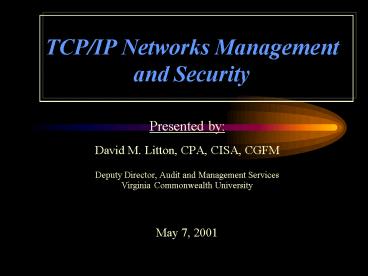TCPIP Networks Management and Security - PowerPoint PPT Presentation
1 / 40
Title:
TCPIP Networks Management and Security
Description:
... network utilities: layers 5-7; FTP, HTTP, NFS, X-Windows, Telnet... Chargen,Discard,Echo TCP/UDP 9,19,7. Windows Sharing. TCP 135-139,445. Berkley R-Commands ... – PowerPoint PPT presentation
Number of Views:136
Avg rating:3.0/5.0
Title: TCPIP Networks Management and Security
1
TCP/IP Networks Management and Security
- Presented by
- David M. Litton, CPA, CISA, CGFM
- Deputy Director, Audit and Management Services
- Virginia Commonwealth University
- May 7, 2001
2
(No Transcript)
3
Course Objectives
- What is a TCP/IP Network?
- Common components of a TCP/IP network
- Network environment TCP/IP protocol and
associated devices functionality - General network risks
- Specific risks and compensating controls for
TCP/IP network devices - Areas of a TCP/IP Infrastructure Audit
4
What is a TCP/IP Network?
- Envelope and post office concept
- Ethernet Frames
- Internet Protocol (IP) Connectionless datagram
tries to send but not sure if it gets there - Transmission Control Protocol (TCP)
- Alternatives to TCP UDP and ICMP
- Ports
- Socket (Combination of port IP address)
- Connection (pair of sockets for a session)
5
(No Transcript)
6
(No Transcript)
7
(No Transcript)
8
(No Transcript)
9
(No Transcript)
10
(No Transcript)
11
(No Transcript)
12
(No Transcript)
13
(No Transcript)
14
(No Transcript)
15
OSI Model and TCP/IP Compared
16
(No Transcript)
17
Common components of a TCP/IP network
- Cat 5 UTP Wiring fiber optics lower layer 1
- Hubs emphasis layer 1
- Bridges layer 1 or lower-part of layer 2 (MAC)
- Switches some layer 1 emphasis layer 2
- Routers emphasis layer 3 some layer 4
- Applications/network utilities layers 5-7 FTP,
HTTP, NFS, X-Windows, Telnet - Protocol Stacks part of server/work station O/S
- Servers - physical and logical contrasted
- Specialized IP servers DHCP, BOOTP, DNS
18
Network Environment TCP/IP Protocol and
Associated Devices Functionality
19
LAN/WAN Protocol Example
20
General network risks
- Inconsistently applied back-up procedures for
Network Equipment and Servers - Lack of a test lab and change control procedures
- Intercepting clear text, log-on identifiers and
passwords - Staff turn-over
- Use of unauthenticated services on network hosts
and pass through routers - Lack of spoofing prevention measures
- Use of default passwords on network equipment
- Lack of password change procedures for network
equipment - Poor O/S controls on network devices
21
General network risks
- Improper access to restricted systems (patient
information, financial records, payroll, etc.) - Release of sensitive information
- Prolonged outages and inconsistent availability
- Lack of documentation
- Non-compartmentalized traffic
- Trojan Horses
- Lack of expertise, training, and cross-training
- Lack of restoration plans or spare parts
- Ineffective procedures
- Masquerading as another individual
- Spying, Sabotage
- Risk from easy-to-use freeware utilities
- Stolen Passwords
22
Specific risks and compensating controls for
TCP/IP network devices
23
Router Risks and Controls
24
Router Risks and Controls
25
Router Risks and Controls
26
Router Risks and ControlsMethods of Accessing
Routers
- Console
- TFTP
- Telnet
- TACACS
- MOP (maintenance operation protocol by DEC for
CISCO routers)
- SNMP
- R-Shell
- R-Copy
- FTP
- HTTP
- More being added, check manufacturer documentation
27
Domain Name ServiceRisks and
Controls
28
Network Address Translation
29
TCP/IP Environment Example
30
Wiring/Hubs Risks and Controls
31
Additional Server Risks and
Controls
32
Dangerous Services to be Restricted
33
Work Stations Risks and Controls
34
Encryption
- Examine Encryption Practices
- Determine where the traffic is the most exposed
going out on the Internet, between business
partners - Look for controls like compartmentalization
VLANs to reduce internal exposure - Use Encrypted methods like SNMP V.2 and CHAP V.2
to communicate to network devices - Consider testing encryption controls with a
sniffer
35
Sniffed PPP Connection in Clear Text
36
Areas of a TCP/IP Infrastructure Audit Why
Examine Network Infrastructure
- Rarely examined
- Large investment
- Basis for most technology - the common
denominator - Connects to the World
- Lost Revenue on E-Commerce
- Susceptible to Denial of Service Attacks
37
Areas of a TCP/IP Infrastructure Audit
Recommended Objectives
- Continuity (consistent reliability and
availability of system -- back-up and ability to
recover) - Management and Maintenance (additions, change
procedures, upgrades, and documentation) - Security (appropriate physical and logical access
to network devices and hosts)
38
Auditing TCP/IP Infrastructure
- Review network policies and procedures
- Review network diagrams (layer 1 2), design,
and walk-through, list of network equipment and
IP address list - Verify diagrams with Ping and Trace Route
- Review utilization, trouble reports helpdesk
procedures - Probe systems (Netscan tools and Portscanner)
- Interview network vendors, users, and network
technicians - Review software settings on network equipment
- Inspect computer room and network locations
- Evaluate back-up and operational procedures
39
Conclusion
- Identify the paths and equipment used to navigate
the network - Identify TCP/IP infrastructure areas of concern
- Break into manageable pieces
- Every network is different and the components and
risks must be fully understood - Identify risks and prioritize
- Dedicate more upfront planning
- RELAX !! Its not that bad !
40
Additional Information
- Presentation located on line at URL
- http//www.vcu.edu/iaweb/iam_welc.html
- Contact information
- dmlitton_at_vcu.edu
- (804) 828-9248































